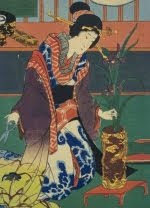Thursday, 25 December 2008
Tuesday, 25 November 2008
Matching Colors
Red to Yellow; Ilex with red berries, Gerbera and Ranunculus.
Yellow to Red - Gerbera and Ranunculus with a branch of Siberian Dogwood.
Orange; Ilex, Gerbera and Ranunculus.
Sunday, 23 November 2008
Simplifying Things
A branch from the garden, an orange Gerbera, and a Bergenia leaf.
Use only as much as you need - nothing more. That's the secret of ikebana. It could also be a way of living if you wish. Not as easy as it sounds. These are really simplified arrangements with not a leaf that isn't necessary. At least that is what I have aimed for.
Gerbera and Berberis in a simplistic vase.
Wednesday, 12 November 2008
Winter Visions
Ornithoglaum and some green stuff in a boat container
Snowberries (Symphoricarpos) and some more of the green stuff
Ornithogalum with a dry leaf and green plant material.
Sunday, 9 November 2008
Tea Flowers
Here is my Chabana arrangement from the ikebana class at the Japanese tea house. Two kinds of grass, a Bergenia leaf and some humble autumn flowers.
There should always be two lines in a chabana arrangement, one for the tea master and one for the guest. In this case the high grass and the Bergenia leaf represents those lines.
Tea for Three
Saturday, 8 November 2008
Kiku and Kawana in the Big Apple
Flower Obsession

The Martial Way and the Way of Flowers
Wednesday, 29 October 2008
Maze-ZaShi
Tuesday, 7 October 2008
More Leaves
Monday, 6 October 2008
Raku in South of France


Saturday, 4 October 2008
Flexibility and Strength
Nothing but Branches
Tuesday, 30 September 2008
Browsing Through Time

Autumn Leaves
Just Flowers
Monday, 25 August 2008
Straigth Green Lines
Sunday, 10 August 2008
When Warhol met Sofu

Sunday, 3 August 2008
2 (or 3) x Warhol


Monday, 28 July 2008
Bringing Art to Everyday Life


Tuesday, 22 July 2008
Norwegian Romanticism - Japanese Style

Summertime












